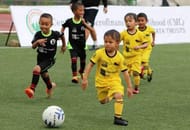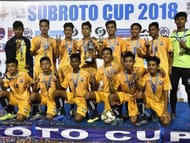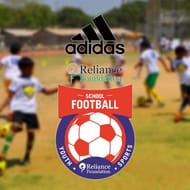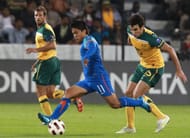Disclaimer: The views of the author do not necessarily reflect those of Sportskeeda.
Football in India has always been a start and stop journey. While some of us hope to see India as a footballing giant someday, others are worried about our domestic football system. But the keyword in both voices has always been grassroots development.
While different organizations have said more than they have done towards achieving this, here, we discuss a possible system and its implications with regard to future footballers in the country.
Indian football had a 'Golden Era' in the 1950s and 60s, playing football through the eyes of coach Syed Abdul Rahim's advanced tactics and conquering Asia. The team competed with the likes of France and South Korea, regulars in today's World Cups.
But things went topsy-turvy from there. Asian titles dried up, with only a few appearances in the Asian Games and some more in the Nehru Cup to show for. But in 1996, a domestic football overhaul took place with the birth of a National Football League. Some years later, it was re-branded as the I-league.
Then came 2010, when Reliance Industries came with financial aid to prepare India for the 2011 Asian cup, and in exchange, received exclusive rights to start the glamorous ISL. While India had a forgettable 2011 Asian cup, the company's influence only grew, and the ISL is now India's official national league.
While there's so much about men's football, women's football on the other side has largely been a joke to the AIFF, although the eves' side is higher ranked in FIFA terms, and has made positive strides towards Olympic qualification in recent times.
While there is no doubt that the ISL has brought in the much-needed money and professionalism, most of its grassroots development has been largely superficial. Having a 'fest' and calling a few kids to kick about a ball for an hour is not going to take us anywhere closer to a world cup.
Our national team needs way more exposure, and this can be only achieved by playing lots of invitational/semi-pro tournaments and setting targets for AFC and FIFA championships.
Recently, the AIFF, in collaboration with the AFC has released the much-awaited road-map for the top divisions of Indian Football, which is a five-year plan.
While it has been a win-win solution for most stakeholders, some experts are still worried and are complaining that five years is a long time.
We, on the other hand, find that five years as a blessing in disguise. While the top divisions will go on, AIFF has bought themselves five years to fix the domestic football mess. The system can be made more comprehensive, fixing all the loopholes.
What we need is a solid developmental structure, where boys and girls get immense game time, coaches and referees have a good career option, and a system that is viable in the long run.
Funnily enough, more than half of this system we discuss below already exists! Now it's just about integrating these bits to help future footballers realize theirs and a nation's dream of bringing back the glory days.
(In this segment, we've discussed men's football. Women's football will be exclusively discussed in another article)
THE SYSTEM:
Age Classification:
5-10 yrs (Until Class 5) => Boys and Girls together
Boys
Under 12 (Class 5 and 6)
Under 14 (Class 7 and 8)
Under 16 (Class 9 and 10)
Under 18 (Class 11 and 12)
Under 21 (University Level)
[ move on to senior-level ]
The current AIFF divisions are fairly similar, but there is a need for a slight change. With this system in place, age fraud can be checked at regular intervals. The education levels have been mentioned keeping the school tournaments in mind. In the following slides, we also elaborate on what the AIFF's international targets at every age group level should be.
[ Age group rules are to be specified by the AIFF at the start of every season, in collaboration with the players' association (FPAI), as well as the Indian Central and State level school Boards. These age groups have also been suitably drawn up to select junior national teams ]
Domestic Tournaments: (Scheduling and format)
The scheduling of these tournaments need to be made with certain factors in mind:
- The last half of February and the whole of March should be given as an off-season due to school final exams.
- There needs to be a two-week break in September for mid-terms.
- There will be certain transfer windows at every age level, where club level transfers take place under the purview of the AIFF to avoid age and money fraud.
- The start of the season is considered as June, as most schools in India reopen by then.
SCHOOL LEVEL:
Until the Under 12 level, i.e from ages 5 to 10, the AIFF should continue developing it's Golden Baby Leagues initiative, in collaboration with Reliance's efforts. The Baby League was a masterstroke move in recent times.
Boys and girls can all play semi-professionally on AstroTurf grounds in towns and cities, under the guidance of school and academy coaches. Kids can also play on primary school grounds, public parks, local tourneys, etc. The main aim here is to get as many kids as possible to participate and let the kids play for fun. Those who are interested and/or have some talent will surely move forward to the next level.

BOYS:
UNDER 12
Children would just about move into middle school, and now is the time to introduce them to some professionalism. School teams can be formed, and play the U-12 Reliance Foundation Cup in June and July (hoping that Reliance will be expanding the qualifiers to all parts of India in the coming years).
Clubs hold trials and select players in late July (as per FIFA and AIFF regulations), and the Under-12 I league is held from August to September. School teams can continue playing other age-group city-level tournaments (both 11-a side and not). Players train at school, as well as personally at academies, public grounds, etc.
The target for AIFF: To get players used to a professional level, and try and make boys play as many matches as possible to improve aspects of the game like first touch, passing, dribbling, game awareness, etc. which is better developed at a younger age. Clubs sign their first academy products. No targets at the International level.
UNDER 14:

June-July: Subroto Cup qualifiers to take place in every state (responsibility of AIFF), conducted by the Armed forces in association with State Associations. The state association could use the Armed forces' facilities and conduct a comprehensive state-level school football championship (well-structured like cricket).
The winner represents the state in the Subroto Cup in Delhi. Apart from this, players can continue playing amateur tournaments for school and their academies/semi-pro sides. The state uses this tournament to scout players for the U-14 State team.
August-September: Subroto Cup finals take place in Delhi. First National Team is selected from here. The last half of September is given as a break for Mid-term and Dusshera.
October: State teams are selected and National Championship takes place. Here comes a Diwali transfer window, where top division clubs can hold trials and sign players as per FIFA and AIFF rules. If a player is shifted to a residential academy, he must be registered to a school and must pursue education.
November-February: U-15 I-league kicks off (Transition to U-15 as the year changes). Players who are not a part of this can play the CBSE/ICSE/State Board championships for their schools. National teams selected from among these players whenever a match comes up. A break until the end of March after the end of the league.
April-May: Another transfer window in April, where clubs hold trials, scout players, etc. Players play the U-15 Nike Cup for their clubs in these two months. As schools are generally closed during this time, players who are not a part of this continue playing semi-pro or train at academies.
Targets for AIFF: Firstly, playing the AFC U-14 championships. Then, selecting a strong U-15 side and win the SAFF Championships. Playing friendlies against top sides home and away. Play tournaments like Gothia Cup and other age-group tournaments for exposure. Later merge this squad with the U-16 team selected and become regulars at the AFC U-16 championships. Then go towards targeting the U-17 World Cup.
Domestically, players should play at least 30 games in a year. Game-time is always a key factor in improving technically and tactically for all players.
UNDER 16
A very similar structure to the U-14 level, just that they play the U-16 Reliance cup in August, with state-level qualifiers/championship in June and July. A state team is then selected for the national championship in October, after the September break.
School teams play the CBSE/ICSE/State Board championships in November and December. A state team is again selected at the end of December, for the Khelo India U-17 championships in January and February. Another break in March.
No professional football in April and May due to 10th board results, changes from school to pre-university and extra classes. Players can play semi-pro and train.
Club transfer windows at the end of August (After the Reliance cup) and at the end of February (After Khelo India). National U-16 team to be selected for the AFC U-16 championships and merged with the previous outgoing batch.
Targets for AIFF: Qualifying for the AFC U-16 Championships regularly, and then pushing for a berth at the FIFA U-17 World cup. Also playing friendly matches and tournaments against top oppositions.

UNDER 18
This is a major age group for all players - in terms of club and national team football. But institutions and schools do have an important part to play as well, as this is a phase that will shape one's professional career. A lot can be achieved in this span of two years.
April-May: Institutions play a nation-wide U-18 Reliance Knockout Cup (mainly players going from 11th to 12th class), which also includes academies accredited by the AIFF (AIFF should continue recognizing residential academies).
In this way, clubs also take part in a comprehensive scouting and selection process and bring in players in June-July, and then send them to the club academies. In this way, the incoming U-18 players are aligned with the normal summer transfer window.
August to February: The clubs then play a national U-18 I League from with match-days on weekends on excellent quality pitches. These players then directly graduate to senior level from within the club or get loaned/transferred out. A break in March for the final exams.
For players who don't play for clubs:
June-July: Institution teams play U-17 Subroto Cup state-level qualifiers, which are held in collaboration with all the state FA's and the Armed Forces. The Subroto Cup finals take place in Delhi in August. The winner of the Subroto Cup qualifies as India's representative at the Asian School Football Championships.
Then after the September break, State sides are selected for the national championships in October.
November-December: the CBSE/ICSE/State board championships take place.
January to mid-February: The U-18 National School Games (organized by the School Games Federation of India) takes place, with extensive state-level qualifiers.
A break from mid-February until the end of March for the final exams.
April-May: As most of these institutes do function for most of the time, they take part in the Reliance U-18 Knockout cup.
Targets for AIFF: Win the SAFF U-18 Championships. Make the National team play lots and lots of friendlies and tournaments (like Toulon cup, COTIFcup, Granatkin cup, etc.) to prepare them for the AFC U-19 championships.
The bigger picture here is the FIFA U-20 world cup. Potential stars for our national team could be identified and be fast-tracked.
University Football (U-21)
Though most players wouldn't choose this pathway, as most of the future professional players would graduate to a senior level from their club sides. But still, we need university football to keep our youth engaged, and hope to find some more talents (India, after all, is a vast country).
State FA's should start conducting a University League involving all national level, state level, and private colleges wherein U-21 teams play a structured home and away format league (maybe with divisions in the league system), since many universities in India do have huge grounds. This league runs from August to December. From this, state sides are selected for the U-21 Khelo India Games in January and February. They then play other state level and local competitions until May.
Players can be signed from here into the reserve teams of top clubs, or by lower-division teams in the regular transfer windows.

Targets for AIFF: Select good developmental U-21 sides from clubs and universities, and play as many international semi-pro invitational tournaments and friendlies as possible.
Prepare a strong U-23 side for the Asian Championships, as well as the Asian Games and hopefully the Olympics. Integration to the National team should always be the primary objective with the style of play suiting the National team.
This team should also play the senior SAFF Cup, as well as the South Asian Games and aim to win it.
Scope of this plan
This is a comprehensive system and will benefit existing school level coaches, as well as unearth new coaching talent. School coaches could double-up as academy coaches for the evenings or weekends, thus enhancing their earnings.
More schools need to be encouraged to participate in the national-level tournaments. This will help more talented players rise through the ranks. Schools will also get national recognition for winning titles, and this would be win-win for players, coaches and all the others involved.
There will be more opportunities for referees, and AIFF should encourage people to pursue refereeing as a career option. India needs quality referees, and the AIFF can unearth some gems from the system. The AIFF must make a better effort towards treating referees considering the apathy the current ones go through.
Moreover, this plan is beneficial for the clubs and the national team as scouts get to see a varied group of players, and can hence judge their skill-set correctly.

Most of this plan already exists; it's just about making the timings and duration align one after the other, and to make the necessary additions. Our usage of existing facilities will also improve. For example, the AIFF will certainly benefit if it is allowed to use the Armed Forces' facilities for the Subroto Cup.
Plus, if children represent their school, it means that they are attending school. So our next batch of footballers will be well-educated and will not fall for false promises. They will also be able to communicate better with foreign coaches and referees, and this will help them greatly if they get to play abroad.
This kind of plan creates amazing job opportunities for coaches, referees, scouts, and many professionals. While the plan for the top division has already been made, it is the grass-root development that we need to always prioritize. If this kind of plan is implemented, we can hopefully see India at a World Cup in the next 5-6 years.
It's all out there; if we have a plan, and stick to it, and follow it with discipline, there is no reason why we can't be playing world cups. Hence arises the question: to be or not to be? The ball is in the court of the federation. It's high time we made some changes to ensure realistic grassroots development.
